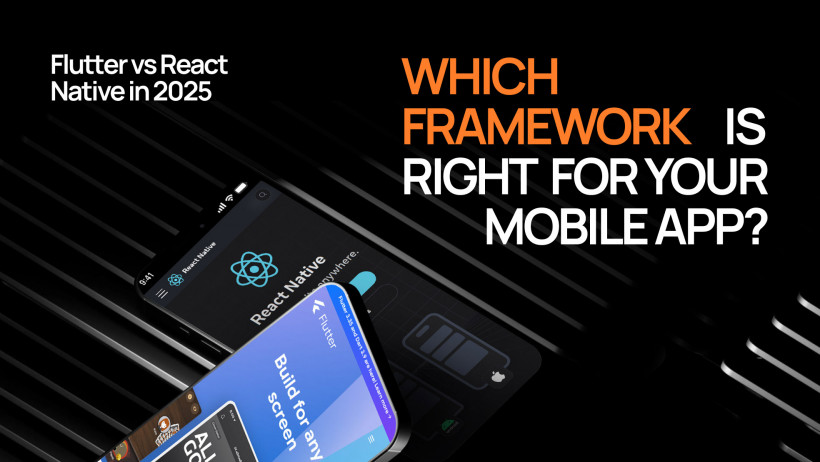When clients approach us for mobile development to cover several OSes at once, they often hesitate between these two popular frameworks. We've dealt with both of them, and today, we can confidently say: the ultimate choice depends on many factors, like planned functionality, UX requirements, as well as time-to-market constraints and, of course, budget. Below, we'll share our insights on how to make a well-informed choice.
Frameworks’ Overview
.jpg)
Over decades of our experience in mobile development, we've worked on hundreds of projects where the right technology stack sped up product launches by months, while the wrong choice led to frequent rework and budget inflation. So, let's start our mobile app framework comparison with their brief overviews to outline the tasks for which each is best suited.
Flutter is Google's project based on Dart. It has its own Skia rendering engine (although the team is currently actively working on a new backend, Impeller), which provides ahead-of-time compilation to native code and uses JIT in debug mode. Flutter's main feature is that it renders the entire UI natively, without the native platform widgets’ help. This ensures that technical teams obtain a predictable design for their mobile apps across all supported operating systems.
It also includes low-level features like CustomPainter, shaders, and GPU access, which can be useful when working on products with non-trivial UIs, as well as complex animation and graphics. In general, we typically rely on this framework when a project requires complete visual consistency while maintaining a unified UI codebase.
Talking about React Native, a proprietary solution from the Meta team, it’s based on JavaScript and TypeScript. Its UI relies on native mobile platform components, while business logic is executed in the JavaScript runtime. The most recent RN versions also utilize JSI/TurboModules and Fabric, which remove the limitations of the bridge.
So, if you need direct access to platform APIs, typical-to-OS behavior, and a consistent UI’s look and feel, or you already have an existing JS/TS web ecosystem, RN is likely to be the top choice.
Development Speed and Productivity
From a practical standpoint, the speed and productivity of a tech team directly depend on the chosen tech stack, as well as logic reuse capabilities and the quality of libraries (usually, it’s determined by the level of community support). In this sense, Flutter provides high UI development speed thanks to declarative widgets and the hot reload feature, while RN is better in terms of ease of integration with the web stack and the availability of an extensive ecosystem and a lot of libraries.
It's also worth considering how Flutter’s hot reload and RN’s fast refresh work, as they determine the speed of iterations. In particular, hot reload ensures reliable widget state restoration; along with that, RN's Fast Refresh demonstrates high performance in JS, while React DevTools/Flipper/Hermes provide in-depth diagnostics.
Finally, it's essential to assess the ecosystems’ maturity: RN's npm boasts a huge package base, but the quality of many of them is still doubtful. With its pub.dev, Flutter remains more stable, but it has far fewer libraries.
All these considerations require us to audit third-party plugins in every project through automated dependency scanning and manual verification of components made with proprietary SDKs (optionally, we can resort to comprehensive CI compatibility testing, too). This approach protects the client's SLA and results in reduced emergency payments to engineers with hourly rates to fix bugs discovered after the next upgrade.
Performance and UI Customization
Typically, the architectural approach determines the performance of the software itself. It's important to note that Flutter, thanks to its own rendering engine, makes it easy to handle even the most complex animations and custom UI elements (if the technical team dedicates enough time to widget rebuilds/const widgets and works correctly with resource-intensive calculations). On the other hand, RN relies on the native API access; however, its performance can be insufficient due to frequent bridge calls from JS to native components and back. To avoid this, we strive to minimize the number of bridge calls, implement complex calculations in native components, and optionally rely on Hermes in scenarios where even minimal latency is unacceptable.
Now, a few words about the level of UI customization: if a mobile app requires end-to-end alignment with the functionality, its UX, as well as design of a specific OS, RN will become an obvious choice, as it offers platform-specific elements out of the box, thereby positively impacting the end user's experience. Flutter, on the other hand, allows you to recreate an OS-specific look, but often requires additional refinement and performance benchmarks based on platform specifics. Therefore, if the UX quality is a project's primary focus, we follow a platform-adaptive approach, implementing core logic in a cross-platform format while leaving main screen elements in a native format.
Cost Considerations
Now, let's talk about the total cost of ownership, as it’s also determined to some extent by the technology stack.
Flutter typically minimizes UI development time, while RN, on the contrary, often requires additional costs for hiring additional software engineers to build bridges. However, if you already have a fully staffed JS team, this won't be a problem. Generally, during our first interactions with our clients, we estimate the TCO upfront, taking into account the costs of CI/CD, subscriptions to third-party services, test devices, and technical support during the next 2-3 years.
Here’s another important insight from WEZOM’s experience: although app maintenance of two codebases is initially more expensive than one cross-platform solution, blindly striving to save on development can provoke too labor-intensive integrations and bug fixes (and therefore, in the long run, such a project will cost more than two solutions alone).
So, if you're still unsure which approach to take for your mobile solution, please contact us individually. We'll help you make the right choice and, if necessary, handle the entire SDLC.
Learning Curve and Team Expertise
Like many other software engineers around the world, we appreciated RN's simplicity from the very beginning. Flutter's learning curve is somewhat steeper in this regard: it requires mastery of Dart (a less popular language than JS/TS) and a deep understanding of the widget-based approach. At the same time, regardless of the chosen framework, we always adhere to clearly defined code style guidelines and architectural patterns (such as Clean Architecture). This maximizes the tech team’s productivity and reduces the risk of code inconsistency, making it easy to maintain and upgrade even by external teams.
Furthermore, our experience allows us to seamlessly migrate mobile apps to any of these frameworks if it’s required for the client's current business rules and goals. To achieve this, we typically follow a hybrid strategy: first, we integrate a cross-platform module, and then gradually move main paths into platform-specific components to eliminate long pauses in the release plan.
Real-World Use Cases

The modern mobile software market boasts numerous successful projects built with both frameworks.
Let’s consider Alibaba Group: it uses Flutter in many of its eCommerce products – this can be explained by the need for high-speed interface and absolute UI consistency across different regions. On the other hand, companies like Facebook and Instagram choose RN, which is logical, too: integration with the existing JavaScript infrastructure and tight connection with proprietary SDKs ensure the best balance between performance and flexibility.
That's why, when start working on each mobile project, we always rely on world-renowned applications as a benchmark: if the solution is intended for a large B2C segment and has too sophisticated visual and animation requirements, Flutter will be a priority; however, if complex integrations with existing systems are required, or there is a need to support an well-established codebase, RN is guaranteed to provide greater benefits.
To summarize, here are a few more valuable insights from our experience:
- In startups, we recommend choose Flutter if user engagement through design and UX is crucial, and RN if the client's in-house team already has a strong pool of JavaScript developers and the main priority is to deliver an MVP to the market ASAP.
- In enterprise-level software with a focus on scalability, Flutter will be the best cross platform framework – especially for businesses where UI consistency and a unified visual strategy determine the product ROI. On the other hand, RN will be a better choice for projects that require integrating a mobile app into a well-established ecosystem of corporate services and ensuring long-term support through existing JavaScript resources.
Are you still unsure about what to choose – Flutter or React Native for the app? Write or call us, and we'll build a product building strategy from A to Z that will deliver the highest ROI.

How WEZOM Helps You Choose the Best Framework for Your Needs
To ensure your React Native vs Flutter in 2025 dilemma is resolved correctly and in line with your goals and constraints, we begin our collaboration with an end-to-end business analysis, assessing your objectives, competitors, and your software’s TA. After that, we model various scenarios: calculate the cost of ownership for the app over the next several years for both frameworks, as well as evaluate the risks of performance loss, missed deadlines, and hidden technical support expenses. This approach allows us to rule out the wrong choice during the Discovery Session and justify the decision with specific figures.
In team staffing, if we set on Flutter, we involve specialists in custom UI components and animations. If RN is at the center of the tech stack, we focus on integration with existing services, setting up bridges for working with native SDKs, and optimizing CI/CD processes. In both cases, these approaches provide us with additional flexibility, ensuring gradual project growth over the long term.
With us, you won't be left alone after the product’s release: we'll take over performance monitoring, update dependencies as needed, and adapt the code to new iOS and Android versions. All these practices minimize the likelihood of negative feedback, while ensuring stable growth in the most important business metrics without inflating your budget.
If you'd like to learn more about our cross-platform development approach, be sure to check out this page.
Conclusion
So, what should you choose in the Flutter vs React Native couple? Generally speaking, they are undoubtedly considered among the most powerful cross-platform solutions, but choosing the optimal option for a specific project can be difficult without years of technical experience. That's where we can help – both in choosing the best tech stack and in implementing support for the mobile app itself. So, don’t waste a minute – contact us already today.

